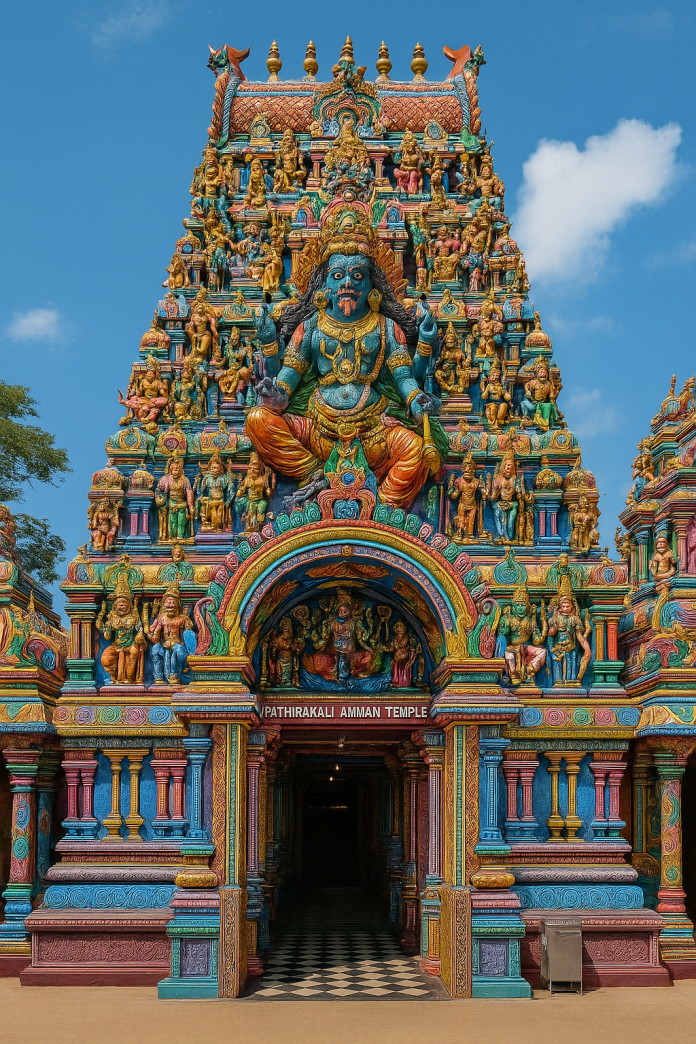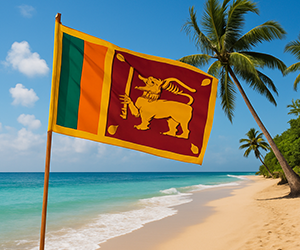🔹 Introduction
In the heart of Trincomalee, a vibrant coastal city on Sri Lanka’s eastern shore, stands one of the most colorful and spiritually powerful Hindu temples in the country—the Pathirakali Amman Temple. Also referred to as the Kali Kovil, this magnificent shrine is dedicated to Goddess Bhadrakali, a fierce and compassionate form of the divine feminine in Hinduism. With its towering gopuram, intricate sculptures, and richly painted walls, the temple is not only a place of worship but also a masterpiece of Dravidian architecture and Tamil cultural heritage.
The Pathirakali Amman Temple is a beacon for devotees and travelers alike. While devotees come seeking blessings, protection, and healing, visitors are drawn by its architectural beauty and deep cultural resonance. The temple is closely associated with the nearby Koneswaram Temple, forming a sacred axis in Trincomalee’s spiritual landscape.
This guide explores the deep religious, historical, and architectural significance of the Pathirakali Amman Temple, along with practical tips for visiting, nearby attractions, and cultural context. Whether you’re on a spiritual journey or a cultural exploration, this iconic site promises a profound and unforgettable experience.
🔹 History of the Temple
The origins of the Pathirakali Amman Temple date back over a thousand years, though the current structure has seen renovations and restorations across centuries. Historical records and oral traditions trace the temple’s beginnings to ancient Tamil dynasties, such as the Cholas and Pandyas, who patronized Hindu shrines across South India and Sri Lanka.
The temple gained prominence during the classical era of Saivism in Sri Lanka, closely linked with the Koneswaram Temple, which is also dedicated to Lord Shiva. Together, these two temples form a part of the Pancha Ishwarams—the five sacred abodes of Lord Shiva on the island.
During the Portuguese colonization, many Hindu temples were destroyed or defaced, but the Pathirakali Amman Temple survived, though it suffered damages. Later, under Dutch and British rule, Hindu worship practices were suppressed but persisted in private and in temple precincts.
In the 20th century, with the rise of cultural preservation and religious revivalism, the temple was restored and expanded. Today, it is one of the most respected and actively visited Hindu temples in Sri Lanka, hosting thousands of worshippers and tourists every year.
🔹 Religious Significance
Pathirakali Amman Temple is dedicated to Goddess Bhadrakali, a fierce incarnation of Goddess Parvati. She represents power, time, transformation, and the destruction of evil. In Tamil Shaivism and Shaktism, Kali is both feared and revered, symbolizing divine justice and unconditional protection.
The temple is a center for rituals, prayers, and festivals that align with the Tamil Hindu calendar. Devotees come to seek blessings for health, fertility, protection from harm, and spiritual liberation. Key daily rituals include:
- Abhishekam (ritual bathing) of the goddess idol
- Offerings of flowers, fruits, and incense
- Chanting of mantras and sacred hymns
- Lighting of oil lamps
During festivals, the temple becomes a hub of music, dance, and communal devotion, with vibrant processions and traditional performances that attract thousands of pilgrims from across Sri Lanka and South India.
🔹 Myths and Legends
The mythology surrounding Goddess Bhadrakali and her temple is deeply woven into Sri Lankan Tamil folklore. According to legend, the goddess descended in her fierce form to protect the world from evil demons, a common theme in Hindu mythology.
One local belief suggests that Kali appeared in Trincomalee to guard the sacred Shiva linga of Koneswaram Temple, cementing the connection between the two sites. Her divine presence is said to manifest in the temple during certain moon phases and festivals, a belief upheld by generations of devotees.
Another legend recounts that the goddess watches over women and children, offering them protection from illness and misfortune. As such, it’s common to see families performing pujas and naming ceremonies in her honor.
These stories are beautifully represented in the murals and sculptures throughout the temple, bringing mythology to life for visitors.
🔹 Architecture and Design
Pathirakali Amman Temple is a brilliant example of Dravidian temple architecture, reflecting influences from ancient Tamil Nadu. The most eye-catching feature is the gopuram, or gateway tower, which is adorned with an explosion of color and intricate carvings.
The temple complex includes:
- A central sanctum housing the goddess’s idol
- Several sub-shrines dedicated to other deities such as Ganesha, Murugan, and Vishnu
- Sculptured pillars and ornate ceilings painted with cosmic symbols
- Wall reliefs depicting stories from the Mahabharata and Ramayana
The temple’s design is meant to inspire awe and reflection, with every element—be it a lion guardian or lotus motif—carrying spiritual symbolism. Visitors often marvel at the blend of artistry and devotion that defines this sacred space.
🔹 Festivals and Celebrations
Festivals at Pathirakali Amman Temple are a spectacular affair. The temple becomes a focal point for Tamil Hindu religious life in Trincomalee during these events. Major festivals include:
- Navaratri: A nine-night festival celebrating the goddess in her various forms. The temple hosts music, dance, and elaborate pujas.
- Thai Pongal: A harvest festival with community feasts and offerings
- Maha Shivaratri: Though focused on Lord Shiva, the goddess is also worshipped alongside
- Aadi Amavasai: A day to honor ancestors and seek Kali’s blessings
During these festivals, the temple grounds are illuminated with oil lamps, and the gopuram is decorated with flower garlands. Cultural performances such as Bharatanatyam and Kavadi processions further elevate the festive atmosphere.
🔹 Visitor Information
If you’re planning to visit Pathirakali Amman Temple, here are a few essentials to know:
- Opening Hours: Daily from 5:30 AM to 12:30 PM, and 4:30 PM to 8:00 PM
- Entry Fee: Free of charge, but donations are welcomed
- Dress Code: Modest attire is required. Shoulders and knees should be covered. Visitors must remove shoes before entering the inner sanctum.
- Photography: Allowed in outer areas; restricted inside the main sanctum unless granted permission
- Facilities: Restrooms, small shops, flower vendors, and nearby eateries available
It’s advisable to visit early in the morning or just before evening puja for a peaceful and spiritual experience.
🔹 Best Time to Visit
The ideal time to visit the Pathirakali Amman Temple is between February and August, when weather conditions are favorable, and major festivals are celebrated.
- February/March: Maha Shivaratri
- April: Tamil and Sinhala New Year
- July/August: Aadi month celebrations
These months offer a chance to experience the temple at its most vibrant, surrounded by cultural color and community spirit.
🔹 Nearby Attractions
The temple’s central location in Trincomalee makes it easy to explore other attractions:
- Koneswaram Temple: A sacred cliffside Shiva temple offering ocean views
- Fort Frederick: A colonial-era fortress with roaming deer and scenic lookouts
- Marble Beach: Ideal for relaxation and swimming
- Dutch Bay and Uppuveli Beach: For coastal exploration
- Hot Springs of Kanniya: Natural thermal springs with cultural relevance
A visit to Pathirakali Amman Temple can easily be part of a full-day or weekend Trincomalee itinerary.
🔹 Tips for Travelers
To make the most of your visit, consider these tips:
- Respect local customs and religious sentiments
- Avoid loud conversations and wear temple-appropriate attire
- Support local artisans and vendors by purchasing flowers or souvenirs
- Carry water and sun protection during day visits
- Learn a few Tamil phrases—locals appreciate the effort!
🔹 Conclusion
The Pathirakali Amman Temple is more than just a religious site—it is a living monument of devotion, culture, and community. With its vivid architecture, sacred ambiance, and profound spiritual heritage, the temple offers an unforgettable experience for anyone visiting Trincomalee.
Whether you’re drawn by the legends of Goddess Kali, the intricate artistry, or the energy of a festive puja, this temple is sure to leave a lasting impression. Add it to your Sri Lanka travel plans and let the goddess’s grace and power inspire your journey.
Explore more sacred and cultural landmarks in Sri Lanka at lanka.guide




